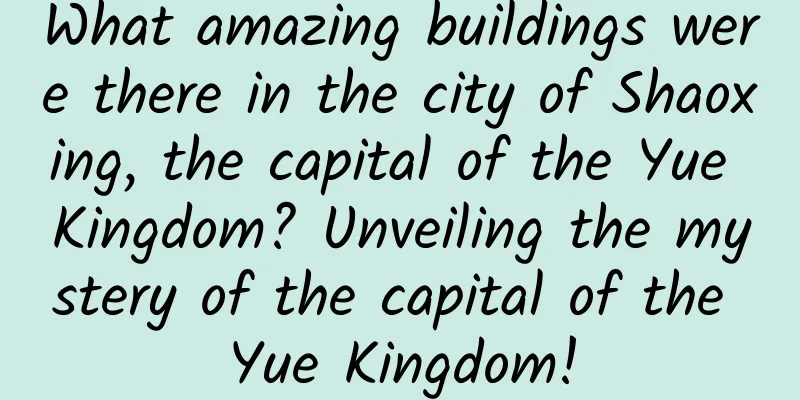What amazing buildings were there in the city of Shaoxing, the capital of the Yue Kingdom? Unveiling the mystery of the capital of the Yue Kingdom!

|
Not long ago, the State Administration of Cultural Heritage held a working meeting on the important progress of the major project "Archaeology China" and released four important results, including the archaeological excavation of the Jizhong site in Shaoxing City, Zhejiang Province. Carbon-14 dating shows that the relevant remains are about 2,500 years old, which confirms the history of Goujian building the capital as recorded in documents and is a major discovery in the archaeology of the Yue State capital. Gou Jian, King of Yue, a famous figure in history books, suddenly "returned" to the city of Shaoxing 2,500 years later... In fact, Shaoxing as the capital of the ancient Yue Kingdom has long been confirmed by historical documents and modern archaeology. The archaeological discovery of the Jizhong site this time did not reveal an unknown history that was not recorded in the literature like the Liangzhu archaeological discovery, but added new evidence to the historical records. As the first country with documented records in Zhejiang history, Yue State occupies an important position in Zhejiang history and even in Chinese history. To cite a few well-known documents, Sima Qian recorded the history of Yue State and Gou Jian's deeds in "Records of the Grand Historian: The Biography of Gou Jian, King of Yue", which clearly pointed out that Kuaiji was the capital of Yue State, that is, Shaoxing. There are also records of Kuaiji in pre-Qin documents such as "Zuo Zhuan" and "Guoyu", which mention Kuaiji as the political center of Yue State. "Yue Jue Shu" and other documents also record that in 490 BC, Gou Jian ordered his minister Fan Li to "establish a country and a city", and chose the swamp plain between Kuaiji Mountain and Hangzhou Bay as the location of the new capital, and established the new capital of Yue State, which later became Shaoxing City. In history, there are actually two "Wuyue". One is the name of the two ancient rival states Wu and Yue during the Spring and Autumn Period, and the other is the Wuyue Kingdom during the Five Dynasties at the end of the Tang Dynasty. Therefore, the Wuyue Kingdom in the Spring and Autumn Period cannot be called the "Wuyue Kingdom". The Wuyue Kingdom established a two-capital system, namely "Western Capital Qiantang Prefecture" (Hangzhou) and "Eastern Capital Ji Prefecture" (Yuezhou). Yuezhou is Shaoxing. Although there are records in documents, to restore history, we must rely on materials other than documents, the most important of which is field archaeology. So, what did the large buildings that Goujian built in Shaoxing City look like? The ruins of Jizhong are the ruins of Jishan Middle School. It is located in the school, in the city center. It only takes three or four minutes to ride a bicycle from the crowded Lu Xun's former residence to the school. "Fuxue Lane" - the name of the lane where the school is located reveals its history. The location of Jishan Middle School is the Minglun Hall Supreme Sutra Pavilion area north of the Dacheng Hall of Shaoxing Fuxue in the Song Dynasty, which is equivalent to the highest level of local official schools in the Song Dynasty. The road where the south gate of the school is located is called Toulaohe Road. There is a Toulaohe Bridge next to it, which is also a story related to Goujian. After "sleeping on firewood and tasting gall", Goujian decided to send troops to attack the State of Wu, and the people of Yue brought fine wine to see him off. Goujian did not enjoy it alone, but poured the wine into the river so that the soldiers in the army could drink it to boost morale. The school discovered large timber during the renovation and expansion project. On September 26, 2023, the Shaoxing Cultural Relics and Archaeology Institute confirmed on-site the presence of Warring States black pottery beans, stamped hard pottery, primitive porcelain cups and other relics, and initially inferred that there may be remains of Yue wooden structures underground. In February 2024, with the approval of the State Administration of Cultural Heritage reported by the Zhejiang Provincial Cultural Relics Bureau, the Shaoxing Cultural Relics and Archaeology Institute began excavating the site. "Look, the green guardrail in front is level with the ground, and the Yue State ruins are five or six meters deep from the surface." Li Longbin, director of the Shaoxing City Cultural Relics and Archaeology Institute, pointed to the excavation shed. In other words, the living area of the people in Shaoxing city is 6 meters away from the capital of Yue State. At present, the excavation area is nearly 3,000 square meters, and the existing accumulations are mainly divided into the Warring States Period, Han and Six Dynasties, Tang and Song Dynasties, etc. At present, more than 40 important relics such as large-scale building foundations, wells, ash pits, etc. have been cleared, and the excavation is still in progress. The magnificent buildings that people imagine are actually made of various large logs, large stone slabs, and large wooden boards at the archaeological excavation site... We can't tell the directions at all, but archaeologists divided the strata and separated the rooms based on these "fragments" and relics. "This is Group A and Group B, over there is Group C, outside is Group D, there should be more, and we are still excavating." As if wearing a pair of AR glasses, four groups of large Han Dynasty buildings stood up in front of Li Longbin's eyes. In hot weather, wet felt cloth was covered on the unearthed wood for protection. The Han Dynasty building foundation is located on the Yue State building foundation. Currently, four groups can be confirmed, with a single area of about 260-400 square meters, which seems to be a large house. The remaining area of Group A and Group B is about 387 and 317 square meters, respectively, and Group C and Group D have not yet been fully revealed. "We are standing on the east side. The building is north-south oriented. The bays are opened like this. The width is 5 bays. Imagine 5 bays. The depth is also 5 bays if we count from our side, but there are extensions on both sides. The final number is unknown." Li Longbin continued to interpret the big wood. "The 3-meter-long board has pillars at both ends. The board is east-west oriented, so it will be 5 rooms." "The things from the Warring States period are well preserved underground. The difference in stratigraphic distance between the Warring States period and the Han Dynasty is about 80 centimeters," said Li Longbin. The most important discoveries this time were all related to architecture. In addition to the Han Dynasty, a group of large-scale building foundations from the Yue State during the Warring States Period were also discovered. Several logs are stacked horizontally and vertically like a bamboo raft to form a net-like structure. This is the unique method of laying the foundation for the Yue people to build houses. The professional name is very vivid, raft-shaped ground, which is stacked like a bamboo raft as a way to build the foundation. "Look, it's like your hands are open and stacked together." Li Longbin used his hands as a "teaching aid" to make it clearer, "a layer underneath, and another layer on top," a bit like baking four or five waffles and stacking them up. At the same time, large pads are added to the 2-4 layers of floor mats stacked vertically and horizontally, and mortise and tenon columns are placed on the pads, so that the floor mats are densely packed and arranged in rows. Why such a complex structure? This is the first time that the Vietnamese people have created a construction method that effectively prevents building subsidence in a wetland environment. If you think about it, the same is true for the isolation design of building foundations made by modern people to resist earthquakes. The Vietnamese people 2,500 years ago had already thought of this. "What kind of buildings need to pay attention to settlement? Large public buildings and government buildings," said Li Longbin. In this area, which is about 48 meters long from east to west and 36 meters wide from north to south, in addition to the first discovery of the original foundation structure of raft-shaped ground, another form can also be observed, which consists of square columns, rectangular pads and round logs under the pads. To put it simply, it is "wooden pads + square columns", which is quite common in the Yue State. The Yue people also lived in stilt houses, which are two different basic construction forms. Li Longbin said that what is interesting is that the wooden pillars placed on the wooden pads are all square pillars with a side length of 20 cm. The archaeological team conducted carbon 14 dating and found that it is 2,500 years old. Next to it is the place where the wood thorns were unearthed. Right here - in the high-level official office building of the Han Dynasty discovered for the first time in Shaoxing area, ink-written characters such as "Hui Ji" and "Shan Yin" were unearthed, which are closely related to Shanyin County of Kuaiji County. It is an important discovery in the archaeology of counties and prefectures of the Han Dynasty and is of great significance to the study of the changes in the county of Kuaiji County. In addition, 13 water wells from the Han and Six Dynasties periods were discovered, all of which were brick-walled structures. Speaking of wells, we have to mention it. The archaeological team is cleaning the C-group buildings. A wooden barrel appears in front of us - not a barrel, but a wooden well from the Yue State. The Warring States well with wooden wall structure is the first to be discovered and has not been cleaned yet. The Liangzhu culture has long discovered square wooden wells in the shape of a well, while the wooden wells of the Yue people are cylindrical and made of a whole piece of log. "The tree is sawed in the middle, hollowed out, and the two halves are closed with saw nails. Imagine that the single-wood coffin in the Yinshan King's Mausoleum was also cut into two halves, but the single-wood coffin was placed upside down, while this well is upright," said Li Longbin. Carbon-14 dating was done on the well wall, and the data showed that it was 2500±30 years ago, which exactly falls on the time when King Gou Jian of Yue built the capital in 490 BC as recorded in historical records. Right next to the well, there is a horse pit where a horse from the Han Dynasty is buried. This shows that the Han Dynasty strata broke through the Yue State strata, which is why we can see the Yue State well and the Han Dynasty horse appear at the same time on the same plane. Boats were the main means of transportation in the south, and horses were rare in the south but more common in the north. "So it's hard to tell right now, but it should be said that (horses) are related to the nature of this group of buildings," said Li Longbin. At present, more than 850 cultural relics of various types and periods have been unearthed, including high-level cultural relics such as bronze washbasins, bronze pots, and crystal rings. Relics related to the metallurgical workshop, such as smelting iron blocks, iron tongs, bundles of iron spears, and groups of iron armor leaves, have also been unearthed. Iron blocks and iron armor leaves were found in the well for unknown reasons. Archaeological excavation is still in progress, and there are many unsolved mysteries. Li Longbin said that an expert discussion meeting will be held later to conduct further research, and the nature of the building can only be determined after the relics are fully confirmed. But at present, a large number of clues point to three words: high level. There is no doubt about this. He particularly mentioned the roof tiles among the unearthed relics, including roof tiles from the Yue State and the Han and Jin Dynasties. Both the quantity and type fully demonstrated that the site was originally a high-level building, which provided important clues for exploring the architectural form and space of the Yue State capital. |
<<: How do smartwatches and fitness trackers reveal our mental state?
Recommend
WeChat now has a small program called "MiXin" for information encryption
Tencent has now launched an information encryptio...
Advertising effect is not good? This is 80% of the reason!
I often hear advertisers complain that SEM promot...
Why do some people sing tone-deaf?
Recently, I often hear my colleague (finally onli...
The strongest winter "assassin" is rain, snow and hail? Wrong, it is actually this!
Snowfall, cooling, freezing rain, strong winds, t...
World Immunization Week丨Why do we need to get vaccinated?
Why do we need to get vaccinated? Vaccination is ...
91 Ten Articles: Ford executive Zhu Jiang may join Xiaomi Motors, Volkswagen electric vehicle deliveries doubled
1. Zhu Jiang, Chief Operating Officer of Ford Chi...
The cherry blossoms are in bloom. I wonder if there are any birds coming to eat the nectar?
The temperature has risen recently, and many area...
Smart cameras become "voyeurism": 100G secretly recorded videos sold for 68 yuan
Home camera cracking software and IP addresses are...
Is there a "sea" in the vast Gobi Desert? It is an "energy supply station" for migratory birds!
In Fuhai County in Altay Prefecture in northern X...
Help! Did this fish steal grandpa’s dentures?
Produced by: Science Popularization China Produce...
These 7 steps helped me reach 1 million users in 6 months
Achieve 100,000 users in 6 months I had just arri...
Is online and offline integration the mainstream strategy for community marketing?
Due to the increasingly fierce competition in tra...
Sun Wuli Illustration Master Class 2021 New Course
Sun Wuli/Famous domestic illustrator With million...
up to date! Data rankings of 60 information flow advertising platforms!
Today I bring you the latest traffic rankings of ...
When getting the new coronavirus vaccine, why do we have to alternate between the left and right arms?
Friends who have received the new coronavirus vac...









